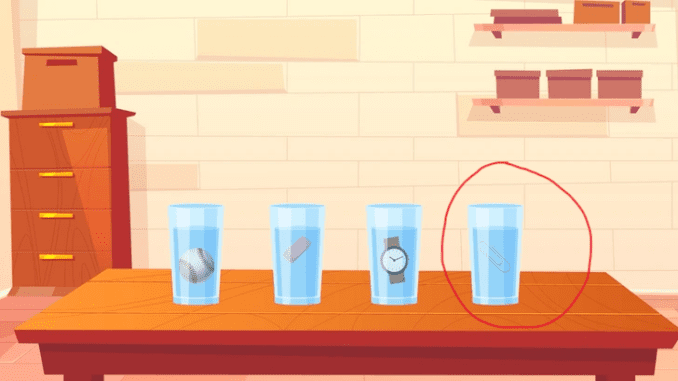Imagine this scenario: four glasses filled to the same level with water, each containing a different object. In one glass, there’s a baseball; in the next, an eraser; another holds a wristwatch; and the last has a paper clip. At first glance, it seems all the glasses contain the same amount of water. But here’s the twist: they don’t! Your challenge? Figure out which glass holds the most water. Ready to dive in? Let’s break it down!
Understanding the Basics of Water Displacement

Before we jump to conclusions, let’s consider an important concept—water displacement. When you place an object into water, it displaces a volume of water equal to the object’s volume. A larger object displaces more water, leaving less space for the water itself. So, the key to solving this puzzle lies in figuring out how much water is displaced by each object and identifying which glass has the most water left.
Overlooking the Object’s Volume
It’s easy to assume that because the water levels appear the same, all the glasses contain the same amount of water. However, this assumption overlooks the fact that each object takes up space in the glass, pushing some of the water out.
Focusing Only on Visible Water Levels
Another common error is focusing solely on the visible water levels and ignoring the objects inside the glasses. Remember, each object displaces a different amount of water, which affects the actual water volume remaining in the glass.
Ignoring Density and Size Differences
People often forget to consider the density and size of each object. A denser or larger object displaces more water, affecting how much water remains in the glass. Failing to account for these differences can lead to incorrect assumptions about which glass has the most water.
With these common mistakes in mind, let’s tackle the puzzle step-by-step to reach the right answer.
Step-by-Step Guide to Solving the Puzzle
Step 1: Assess the Objects
Each glass contains a unique object: a baseball, an eraser, a wristwatch, and a paper clip. These objects vary greatly in size and shape. To find the answer, we need to consider the space each object occupies, which will impact how much water is actually in each glass.
Step 2: Consider Water Displacement
As mentioned earlier, water displacement is the key to solving this puzzle. Larger objects displace more water, so the actual amount of water left in the glass is reduced. Conversely, the glass with the smallest object should contain the most water, as it displaces the least amount.
Step 3: Identify the Smallest Object
Out of the four items, the paper clip is the smallest. It occupies the least space in the glass and, as a result, displaces the least amount of water. In contrast, the larger objects—like the baseball—will displace much more water, leaving less room for the water itself.
Step 4: Deduce the Answer
Now that we’ve established the paper clip as the smallest object, we can conclude that the glass containing it has the most water. Why? Because the paper clip displaces only a minimal amount of water compared to the other objects. In other words, when you remove each object from its respective glass, the glass with the paper clip will show the least reduction in water level, indicating that it contains more actual water.
Answer and Explanation

So, which glass has the most water? The answer is the D glass with the paper clip. Here’s why: although the water levels may appear the same at a glance, the volume of water varies depending on how much each object displaces. Since the paper clip has the smallest volume, it displaces the least water, leaving more water in the glass compared to the others.
Engaging in brain teasers and puzzles like this one isn’t just about having fun. These exercises encourage you to think critically, analyze situations, and consider variables you might otherwise overlook. By challenging your mind, you’re improving your problem-solving abilities and enhancing your attention to detail—skills that can be applied to all sorts of real-life situations.
Did you enjoy the puzzle? Brain teasers like this offer a fun way to stretch your thinking, break down problems step-by-step, and arrive at logical conclusions. And let’s be honest—there’s something satisfying about cracking a puzzle that seemed tricky at first glance!
So, if you got the answer right, give yourself a pat on the back. If not, go back and think about each step. With practice, you’ll find that these puzzles become easier to solve. And why not share this challenge with friends and family? You might be surprised at how many people find themselves stumped.
Ready for more brain-bending fun? Keep exploring different puzzles and watch as your observation and problem-solving skills continue to sharpen. Happy puzzling!